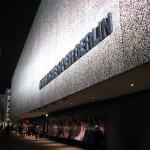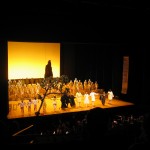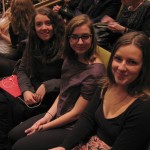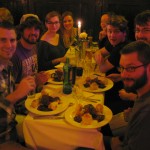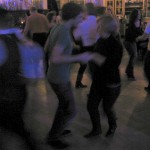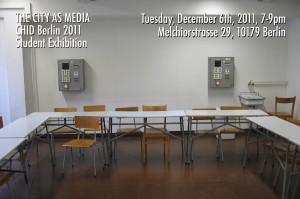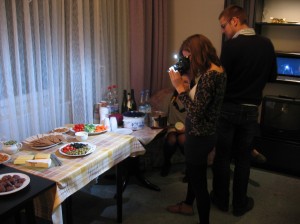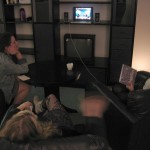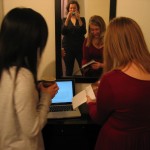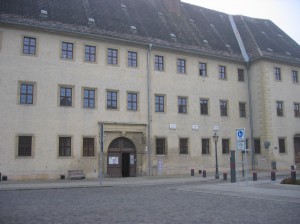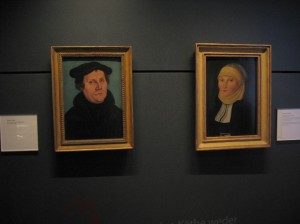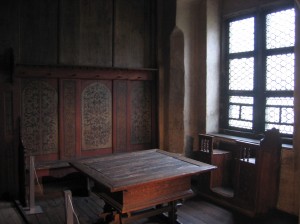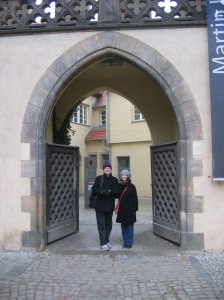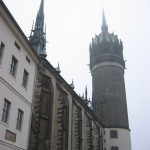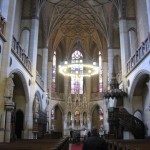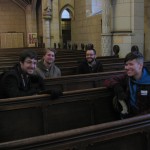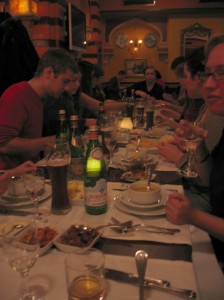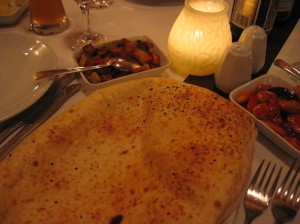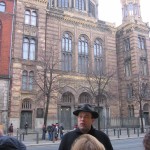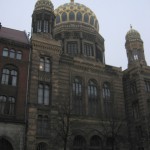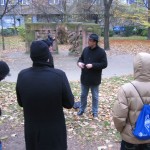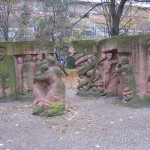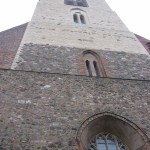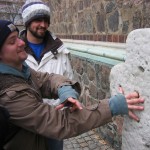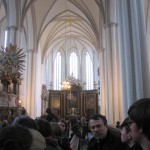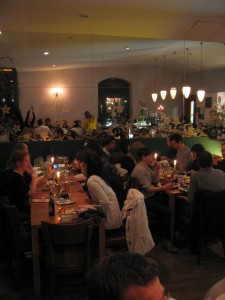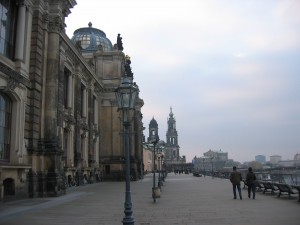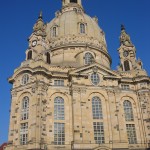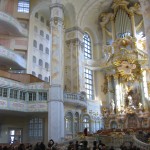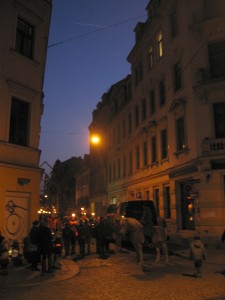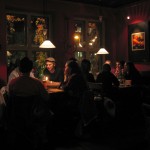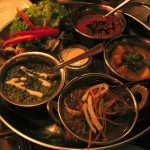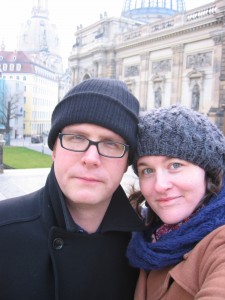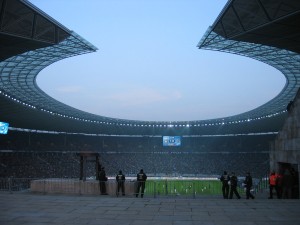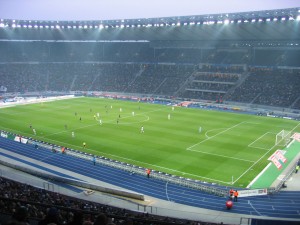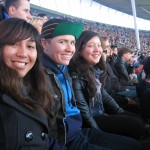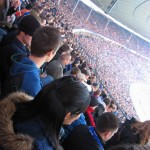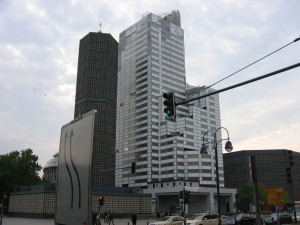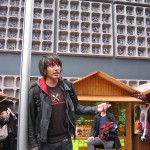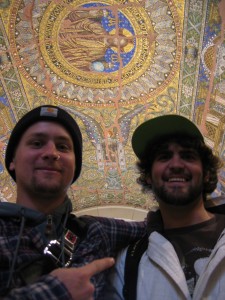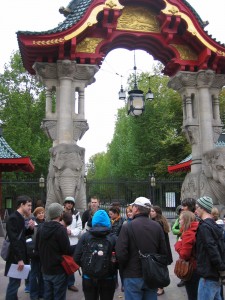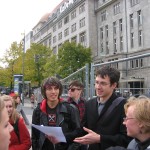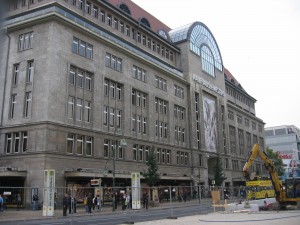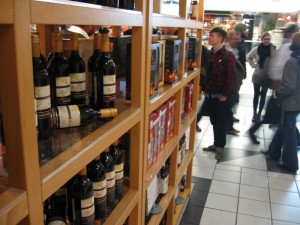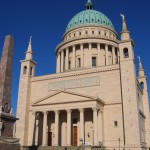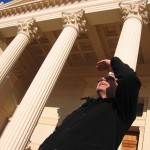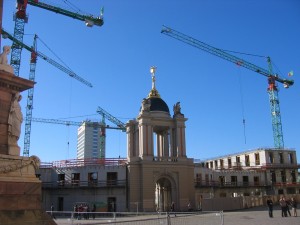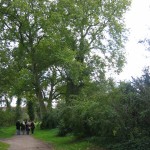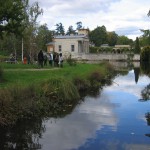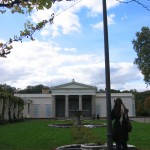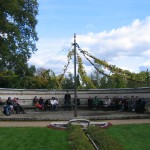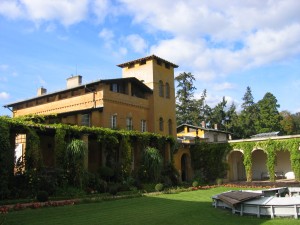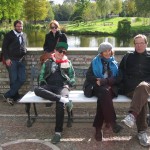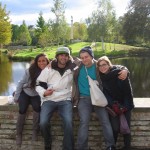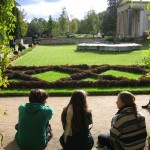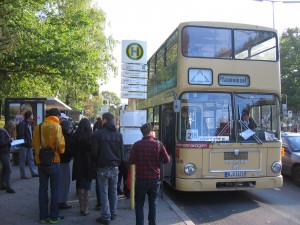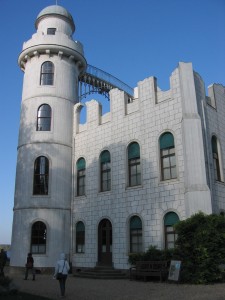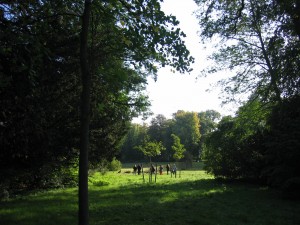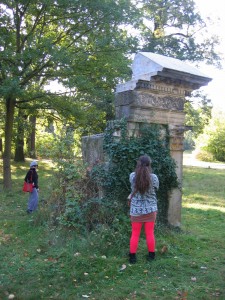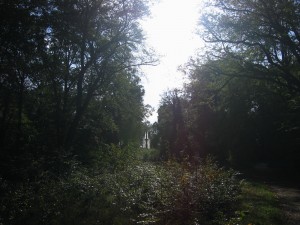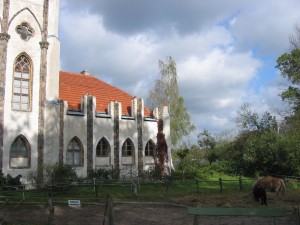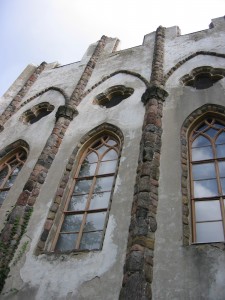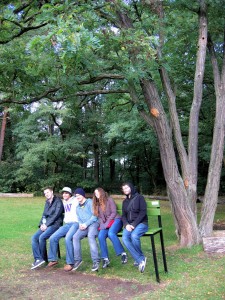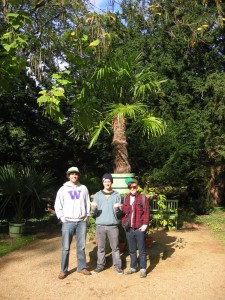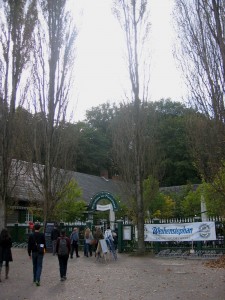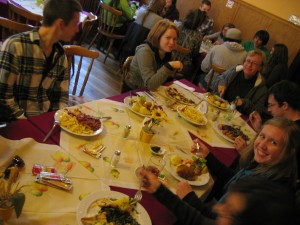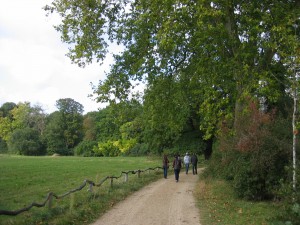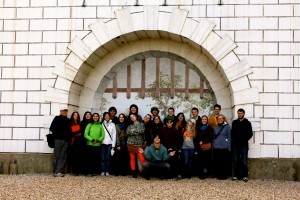Goodbyes
It’s our last week in Berlin!
We sent the students off with two fun activities: first, a trip to the opera to see Mozart’s “The Magic Flute.”
Then, we wrapped everything up with dinner and dancing at Clärchens Ballhaus, a Berlin institution that’s been around since the 1920s. Niguel and Anna tore up the dance floor with some swing moves!
It’s hard to believe that the program is already over! Ten weeks is not nearly enough time to explore a city as rich and layered as Berlin … but I think we did a pretty good job! The students will be moved out and on their way to new destinations by this weekend – some home to Seattle, and some off to explore more of the world! We hope this experience stays with them …
Student Exhibition night!
On Tuesday we held our exhibition of student work at the Adalbertsrasse apartments. Each student installed his or her work in one of the apartment spaces, along with an artist statement explaining the piece. Then we all wandered around and enjoyed their creations, just like at a real art opening.
Everyone helped out with setup, including a lovely spread …
… and the student projects were inspiring! Each one revealed a unique and interesting response to Berlin. (Shown here: Annie’s audio project and Robert’s flip book.) Several guests joined us for an evening of wandering through the building, listening to a spoken-word and music performance, and enjoying being together!
A trip to Wittenberg
This Tuesday we took a day trip to the town of Wittenberg, about an hour away by train.
Wittenberg’s most famous resident was, of course, Martin Luther, who lived here in what was an Augustinian monastery and, after the Reformation, a school and his private residence.
The building is now an excellent museum on the history of the Reformation. One of its best features is the many paintings by Lucas Cranach, who was a close friend of Luther’s. Here are Cranach’s portraits of Luther and his wife Katharina, a former nun. Their marriage has become such a legend that it is reenacted every summer by the locals in Wittenberg!
A few of the rooms are wonderfully preserved, as well. Here is one of the rooms that Luther used as an everyday living space.
(John and Eleanor paused for a quick photo under the portal to Luther’s house.)
The other important site in Wittenberg is the Schlosskirche, where Luther famously nailed his 95 theses on the door in 1517. The church has burned down and been rebuilt since then, but it’s still a pretty amazing piece of history!
One thing that has really been brought home to us – especially in these last weeks, as we discuss contemporary German identity – is just how integral Christian, and in the north, especially Protestant, history is to an understanding of what many people believe it means to be German. This is where it all started, after all! And, as the history of the Reformation shows us, changing people’s assumptions can be difficult. As Germany moves into an age where multiculturalism is increasingly a feature of the social landscape, it will be interesting to see how they make sense of the shifts in religious identity, as well.
Dinner at Hasir
This Monday we had dinner at the Turkish restaurant Hasir! Turkish culture is a huge part of Berlin, and it was wonderful to enjoy some of its culinary delights … YUM!
A tour of Mitte with Ulf Heinsohn
This Tuesday we took a walk through cold, foggy Mitte with Ulf Heinsohn, who helped us unpack some of the layers of meaning in the architecture around us. One of our first stops was the Neue Synagoge, or New Synagogue. Built in the 1860s, the building referred to both the history of Judaism and to its connections with Berlin: the style reflects one of the high points of Jewish culture (the Moorish architecture of the medieval period in Spain, where synagogues took on a look borrowed from Islamic architecture), but it uses a local traditional material (brick).
We also stopped at the Rosenstrasse memorial, which honors the wives of Jewish forced laborers who successfully protested their husbands’ deportation. The memorial was designed by the daughter of one of these couples.
At the Marienkirche, one of the oldest churches in Berlin, we learned how the architecture reflects the changes in the church community. The windowless front of the church was built that way in order to function as a fortress in case of invasion during the late medieval period. The cross in front of the church functioned in “trials by ordeal” — if the accused could fit their fingers in all five holes, they were considered innocent!
Our walk in the cold weather definitely earned us a delicious meal. Our group enjoyed a wonderful dinner together that night at Matzbach, one of our favorite German restaurants!
Dresden: Florence on the Elbe
This Friday and Saturday our class took a trip to Dresden, a beautiful baroque city on the banks of the Elbe River.
The students explored several of the historic sites in the city, including the Frauenkirche. Once a famous ruin symbolizing the firebombing of Dresden, the church has been recently reconstructed.
Since the students were all responsible for seeing the sights on their own, we don’t have images of their explorations, but you can see Annie’s, Mariah’s, Melissa’s or Robert’s blogs for their own photos.
We also learned about an interesting German holiday in Dresden: St. Martin’s Day. Families walk together around the city holding lanterns. All of the cute little kids and their homemade lanterns were quite a sight!
On Friday night, we enjoyed a delicious group dinner at a local Indian restaurant!
… and Chance and I enjoyed Dresden, too!
Cheering on Hertha BSC at Olympia Stadium
This Saturday we headed out to Olympia Stadium to see Berlin’s team Hertha BSC play against Borussia Mönchengladbach. Not only was it fun to cheer on the team, but we got to experience a piece of history! Built under the Nazis, Olympia Stadium was home to the famous 1936 Olympic Games. In 2006, it also hosted the World Cup (the fancy new roof was added then).
Even though our team lost, the students really enjoyed the experience of a true European soccer game – complete with wildly cheering fans. The energy in the stadium was enough to keep us all entertained!
Ku’damm, Zoo and KaDeWe with Robert, Dan and Niguel
Our students Robert, Dan and Niguel took us on a great tour of the Ku’Damm/Zoostation area of Berlin this Tuesday. We began just off the Ku’Damm at the Gedächtniskirche – the ruin of a church built by Kaiser Wilhelm II and bombed in 1943. The ruin has become one of the symbols of Berlin, but you can’t see it at the moment – it’s under that ugly white scaffolding you can see in the picture above. Surrounding the ruin are a chapel and belltower designed by the German modernist Egon Eiermann in the 1950s.
We headed into the ground floor of the ruin first. The ceiling still displays some beautiful Byzantine-style mosaics, duly appreciated by our class …
We then headed next door to the Eiermann-designed chapel. Though the newer buildings aren’t much to look at from the exterior (Berliners have nicknamed them the “lipstick and powder box”), the chapel is pretty stunning on the interior. We caught the organist practicing, which added to the atmosphere.
Our next stop was the zoo, where our guides not only acquainted us with the incredible diversity of its inhabitants – the most in the world! – but related the heartbreaking story of Knut, the baby polar bear born in the zoo in 2006. Knut was a media favorite (with good reason – he really was incredibly adorable!), but unfortunately he died earlier this year.
The mood picked back up as we moved to our last stop, the famous Kaufhaus des Westens, or KaDeWe. It’s the biggest department store in continental Europe, with a history that spans over 100 years.
The top floor of the store is known for its incredible selection of foods, both local and imported. And what should we find as we come up the escalators but a little taste of home – Columbia Crest, on sale. It seems we’re not the only Washington imports to Berlin!
A day in Potsdam
Our day trip to Potsdam featured more of our favorite 19th-century designer, Karl Friedrich Schinkel. (You probably think we’re just obsessed with him, but believe us – he truly was great!) We began at the St. Nikolaikirche near the city center. It was begun according to plans by Schinkel, but finished by his student Ludwig Persius.
Berlin isn’t the only city that is rebuilding past monuments – here you can see that Potsdam is also busily rebuilding its royal palace (across from the Nikolaikirche), as a home for the state parliament. Meanwhile, East German buildings on the other side of the square are slated for demolition and replacement.
A trek across Potsdam and through Sanssouci park brought us to another Schinkel site, this one built for a very elite audience – the crown prince.
Schinkel built a tiny summer palace (really the size of a summer home) for the prince, who was a prolific artist and designer himself. Together, they fashioned what the prince referred to as “Siam” – a utopian space filled with rich symbolism, much of which is now lost on those of us without the proper classical education!
Schinkel also designed a house for the court gardener, which later became a billiards room, tea lounge and general garden leisure space for the prince and his friends.
We took some leisure time ourselves – to contemplate the connection between human constructive activity and that of nature, as Schinkel intended – before heading off on our own walks through the rest of Sanssouci park. Next week: Berlin around the turn of the century!
A day on the Pfaueninsel
On Friday we took a trip about an hour outside of Berlin to a magical place called the Pfaueninsel – Peacock Island – for a class retreat. Our goal wasn’t to engage with official historical narratives so much as to relax and be together in a beautiful natural setting!
After riding the S-Bahn to Wannsee, we got to ride on a classic double-decker bus that took us through the woods to the entrance to the island.
Our first stop on the island was Schloss Pfaueninsel, erected for King Friedrich Wilhelm II and his mistress Wilhelmine Enke in the 1790s. Built from wood, it’s supposed to look like a white ruin on the island of Capri!
Of course, the first thing everyone looked for on the island were the eponymous peacocks – and the students found, and were chased aggressively by – a whole flock of them!
The island contains no end of sublime vistas and interesting architectural follies. It was formerly one of the many pleasure grounds of the Prussian royalty, replete with ridiculous attempts at the picturesque. For instance:
A “dairy” in the form of ruined Gothic church, where the king and his mistress could first play at milking the cows before going upstairs to drink milkshakes in an ornately decorated salon!
The island has some quirky modern works, too …
… and there are allusions to buildings that are no longer there, as well. A palm house designed by Karl Friedrich Schinkel once stood on this site, but it burned down in the late 19th century. A pleasant little palm garden pays homage to the absent building.
Though it was sunny, the weather was quite cold and windy. By lunchtime, we were thankful to sit down in the cozy Wirtshaus zur Pfaueninsel and enjoy some delicious home-style German food. Schnitzel, wild boar, Klopse (meatballs), Flammkuchen and pumpkin soup were all on the menu, accompanied, of course, by generous helpings of potatoes!
As we headed home, I couldn’t help thinking about the royals who had once frequented the island. What were their lives like? How would they have experienced the space? We’ll be finding out more about how they lived this coming week, when we visit Park Sanssouci, home to several royal Prussian palaces.
tags
the author
I'm a doctoral student at CUNY Graduate Center. I'm thrilled to be teaching the CHID Berlin program with Prof. John Toews! You can contact me at naraelle [at] gmail.com, or find out more about me at www.naraelle.net.
Blogroll
- Annie Holden's blog
- Cassie Hoeprich's blog
- Dominic Barrera's blog
- Janet Williams's blog
- Mariah Alderete's blog
- Melissa Au's blog
- Robert Hampton's blog
- UW Students Study Abroad Our students Natalie and Cassie are contributing to the official IPE student blog this fall!



